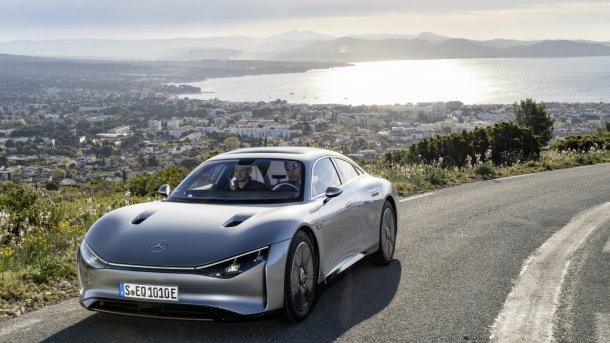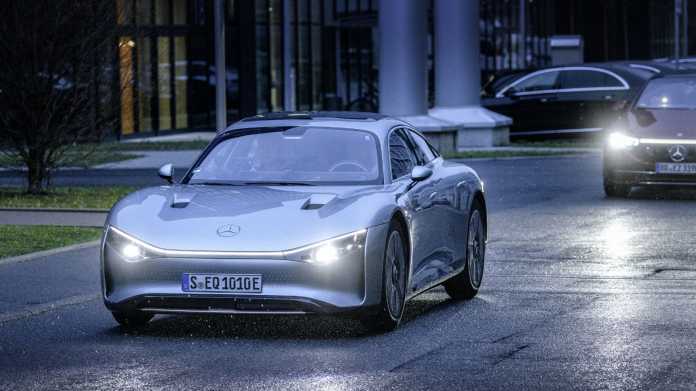The Mercedes-Benz EQXX electric car: Efficiency wins out
Mercedes used only 87 kWh in the EQXX prototype over 1000 km from Sindelfingen to the Côte d'Azur. The implications for series production are interesting.

The ingredients for an economical car have all been known for a long time, they are just not popular at the moment.
(Bild: Mercedes)
- Clemens Gleich
(Hier finden sie die deutsche Version des Beitrags)
"Stopping or recharging was not an option," says Markus Schäfer, Mercedes' Chief Technology Officer, after the Mercedes EQXX's 1000 km drive to the Mediterranean Sea without recharging. That's why the TÜV sealed the charging flap. "There are many range rides," says Schäfer. "Most take place at 30 km/h on a circuit. But we wanted to show a drive under real conditions." So a crossing of the Alps naturally lends itself to that. Above all, it's a 449 m descent from Sindelfingen to the Mediterranean, which is always good for measuring fuel consumption. But otherwise there was no dawdling: The car went up to 140 km/h and the average speed was 87.4 km/h. The net consumption average according to the speedometer at the end: 8.7 kWh/100 km. This means: even including charging losses under 10 kWh/100 km, through rain, over Alpine passes, long motorway stages. How does that work?
The biggest secret
Mercedes communicates the excellent drag coefficient of 0.17, which is achieved by the teardrop shape with elongated rear end, which is extended even further from 60 km/h by servo. In addition, there are clever efficiency systems, which we will talk about in a moment. But the biggest savings are in things that Mercedes customers probably won't want to buy in the end. Look at pictures of the car from the front, in the context of the other cars. This is simply a narrow car (by today's standards), it has a small frontal area of 2.12 m². The EQS, on the other hand, pushes 2.51 m² against the wind. Consider further the well-hidden tyre dimension: 185/65 R20 - significantly narrower than is common in most modern production cars. Bridgestone thus achieved a rolling resistance of only 4.7 per mille for the EQXX tyres. The engineers also built the rear axle 5 cm narrower than the front axle so that the problematic turbulence is in the slipstream of the front. Such a slim hip, however, does not look like what is readily called "powerful" in designer-speak.
Over 1.7 tons heavy
Mercedes-Benz EQXX (8 Bilder)

When it comes to weight, Mercedes talks a lot about "consistent lightweight construction", comparing the EQXX in the press release to a "wiry" cyclist who makes up time uphill. After all, a lot of effort has gone into it, right up to brake discs made of aluminium. However, the car weighs 1755 kg. According to the manufacturer, the 100 kWh battery weighs 495 kg. That leaves 1260 kg for the chassis, electric drive and four seats. By comparison, Volkswagen's small-series XL1 has a battery, electric motor, diesel engine, diesel tank, two seats and a body with scissor doors in 870 kg. Not a prototype, but a small series, and probably the best VW ever. Aptera's "Solar Electric Vehicle" accommodates a 60 kWh battery in 800 kg of vehicle instead of VW's diesel engine, with the option of 100 kWh. Despite the smaller vehicles with two seats, Mercedes can take a leaf out of their book for at least half a tonne before "consistent lightweight construction" comes close to an arguable reality.
Economy recipe vs. current trend
Making a vehicle narrower, smaller, lighter and with thin tyres is the long-known basic recipe for economy. This recipe is countered by current dynamics: Manufacturers want to sell bigger, heavier, wider vehicles because they bring more margin. Customers are courted accordingly and buy cars precisely for reasons of social prestige. This creates a spiral that is difficult to break. A large car, however, will consume a lot of energy even with a good cW value, see BMW iX with its good 0.25, which in our test, thanks to a frontal area of 2.82 m², was nevertheless only good for motorway consumption beyond 30 kWh. Nevertheless, there are of course approaches from the EQXX that also take larger cars a bit further.
Fat Boys Running
Let's move on to the things that could become relevant for series production. Markus Schäfer would like to get into the "low double-digit range" in terms of consumption in series production in the medium term, i.e. close to 10 kWh/100 km instead of around 20 as is usual today. In order to reduce the battery weight, Mercedes mounted the cells in the EQXX directly in the battery pack ("cell to pack") instead of in modules. The module frames are missing, battery weight and volume are reduced.
The downside: a non-modular battery can hardly be repaired. Cell-to-pack is therefore a technology that only makes sense together with its own recycling capacities. Tesla, for example, has announced its intention to develop such a system in order to avoid the high lithium raw material prices that are predicted to persist for decades. Something like this could also work for Mercedes models below the middle class. Above that, it might be smart to stick with modules, because their easy repairability allows for correspondingly long battery guarantees and a prestigious long lifetime for the cars.
Losses and solar energy
A big advantage of higher efficiency: less waste heat is produced. The EQXX cools its systems via a plate in the front underbody area. It provides almost no air resistance. A servo only opens the flap to the large radiator in the front of the vehicle when more air flow is required due to high power demands or (probably more frequently) due to increased air requirements of the air heat pump for cabin heating. When we left Sindelfingen, the thermometer showed only 3 °C, for example. The air flows in at the bottom, through the slanted radiator and out of the two shafts in the front bonnet.
Die Technik des EQXX (4 Bilder)

One optimisation point that makes a difference in all vehicle sizes: minimising losses. Here, the Group brand "Mercedes AMG High Performance Powertrains" (HPP) helped with Formula 1 technology know-how. The result was an efficiency of 95 percent for the powertrain including the converter. This is a value that is normally achieved by good engines WITHOUT a converter. HPP also used experience from the (expiring) use in Formula E, where Mercedes' "EQ" racing engines now exceed 98 percent efficiency.
Low voltage suction
With the low consumption of the EQXX, the consumption of the 12 V low-voltage grid becomes interesting for optimisation. Here, the EQXX basically does what the first Nissan Leaf did: it feeds the 12 V grid via a solar panel on the roof. The Leaf's tiny panel only kept the starter battery charged, whereas the 117 cells of the EQXX supply the low-voltage electrical system with electricity even when the vehicle is moving, which does not have to come from the high-voltage battery. Over a distance of 1000 km with the measured consumption, this results in 25 extra kilometres. In series production, a solar panel could additionally charge the traction battery while stationary via a bidirectional DC-DC converter.
Tips for lower consumption
The 12 V consumers include the numerous powerful control units that do many things automatically that used to require range experience in the driver's seat. The EQXX was on the road for long distances with adaptive cruise control, which pays attention to consumption parameters in addition to traffic. In addition to the automatisms, the systems give the human driver tips for better consumption. We know this from EQA to EQS, where it works well. This will also remain an important part of the series production strategy, because it brings more efficiency to the fleet in terms of production technology.
Interesting detail: The EQXX has normal mirrors, albeit slightly smaller than usual. Although a rear-facing camera gets by with less frontal area, the overall saving in the passenger car sector is small because the camera screens need electricity. Together with the questionable performance of camera mirrors in many areas, Mercedes leaves them out, even in this prototype, where questionable performance would have been an option in view of potentially more PR through cameras.
Comparisons at the end
The EQXX was built with Mercedes' series strategy of large cars in mind. That is why it cannot compete with the XL1 or even the Aptera. Whether anything at all in the direction of the Lightyear One will come from Mercedes is questionable in view of the expected sales figures. It's more about building more efficiency into fundamentally inefficient (but lucrative) big cars. The EQS SUV has just been unveiled and shows where the journey is going: to wherever it's going. Perhaps at some point there will be room for a production efficiency vehicle under the "Smart" brand name. Currently, however, with the 1820 kg weight and SUV shape of the Smart #1, things are going in the diametric direction there.
During the demonstration drive of the EQXX, the crew arrived in Cassis after 12 hours and two minutes (including a 30 minute break with driver change and recharging of the support vehicles) and 1008 kilometres. The battery still showed 15 percent charge. The team would still have made about 140 kilometres with it. For me, the EQXX shows less what would be possible in terms of consumption, because Volkswagen or Aptera show that better. Rather, it shows the potential for savings even in larger cars, which was Mercedes' concern. After all, intelligent optimisation only costs money once, when the car is built. After that, it can significantly reduce both the threshold costs and the energy costs. Since these costs lie with the customer, it is up to us to favour energy-saving vehicles. The current spiral of large prestige vehicles means: unfortunately, there is little to favour. Great opportunity for the next generation of the EQA, Mercedes ...
(cgl)